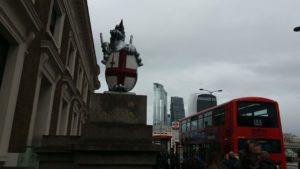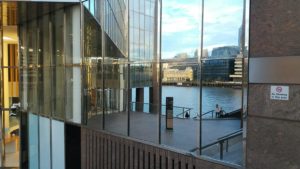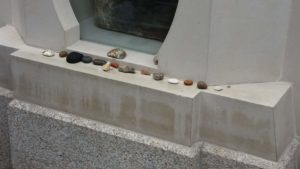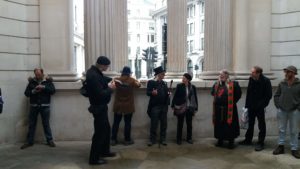Monday 4th November, and it was raining in Brighton. Some of the train lines were flooded but I set out anyway, heading to London Bridge and the 4th annual ‘Reclaim the Sacred’ event.
 The meeting point was the dragon on the South-East corner of London Bridge. This creature sat on top of a pillar which proclaimed the border of the City of London. This area is not a London borough, but is actually a distinct county, the smallest in the UK.
The meeting point was the dragon on the South-East corner of London Bridge. This creature sat on top of a pillar which proclaimed the border of the City of London. This area is not a London borough, but is actually a distinct county, the smallest in the UK.
The plan for the day was to walk through the city of London, performing a series of small rituals. I’d read about the 2018 event in CJ Stone’s blog but still wasn’t entirely sure what to expect.
 Reclaim the Sacred began as “a series of public rituals in order to assert our right to spiritual expression in sacred space”, and there had been incidents in previous years of private security guards trying to stop proceedings for fear that privately-owned public rights-of-way were being used for unsanctioned commercial activity. We had no such interruptions this year, however.
Reclaim the Sacred began as “a series of public rituals in order to assert our right to spiritual expression in sacred space”, and there had been incidents in previous years of private security guards trying to stop proceedings for fear that privately-owned public rights-of-way were being used for unsanctioned commercial activity. We had no such interruptions this year, however.
The day began with a short introduction from CJ Stone, explaining how the event was originally planned as a one-off, but had somehow ended up occurring annually. We then asked the dragons for permission to enter their domain, making the mark of two crosses on our palm (the City coat of arms) and reciting the motto of the city, Domine dirige nos.
 From there we followed a route to Monument for a recital of the Druid’s Vow, then on to the Bank of England. Here, The Money Burner read a section of David Graeber’s book Debt before conducting a small forgiveness ceremony. After that we walked to the Thames, before a final ritual at the London Stone. I’d not seen the London Stone before, although I had read about it in John Higgs’ book Watling Street.
From there we followed a route to Monument for a recital of the Druid’s Vow, then on to the Bank of England. Here, The Money Burner read a section of David Graeber’s book Debt before conducting a small forgiveness ceremony. After that we walked to the Thames, before a final ritual at the London Stone. I’d not seen the London Stone before, although I had read about it in John Higgs’ book Watling Street.
 It felt strange to wander through the City of London on a weekday when we were neither tourists or workers. It was as if we were outside the normal life of the city. I was amazed at how few people seemed to notice our group, looking past us. It reminded me of how the strange beings in Neverwhere went unremarked by passers-by.
It felt strange to wander through the City of London on a weekday when we were neither tourists or workers. It was as if we were outside the normal life of the city. I was amazed at how few people seemed to notice our group, looking past us. It reminded me of how the strange beings in Neverwhere went unremarked by passers-by.
The walk also brought alive aspects of London I’d read about but never really felt. I’ve read a lot of accounts of London as a palimpsest, but I felt this for the first time as we followed a the route of a lost river, the Walbrook. On a square outside a Starbucks, watched over by Melusine, we listened to a poem. One of the group then explained about how archaeologists had dug below where we stood and found bent stylae, which had been given as offerings.
The final ritual involved placing stones we’d brought with us as offerings to the London Stone. I placed a hagstone that had been sitting on my altar.
I went on the walk as an experiment. I’ve been thinking a lot about ritual in the months since the CERN pilgrimage – how it’s vital to modern life, how it differs from habit. Professionally, there’s also the question of how project management methodologies such as Scrum are overwhelmed by their weekly ceremonies, and the place of the daily stand-up ritual. Participating in public, performative rituals was an interesting starting point for exploring questions like these.
We ended the day in a large pub, and split into small groups to chat. It was fascinating to see how different people had come to be there. Everyone I spoke to was friendly, and I was particularly pleased to discover a fellow celebrant was a clown. It was also great to meet King Arthur Pendragon, who I’d read about in John Higgs’ and CJ Stone’s books.
It was a fascinating start to my last week before the new job, and I’m grateful to everyone involved in putting it on.
